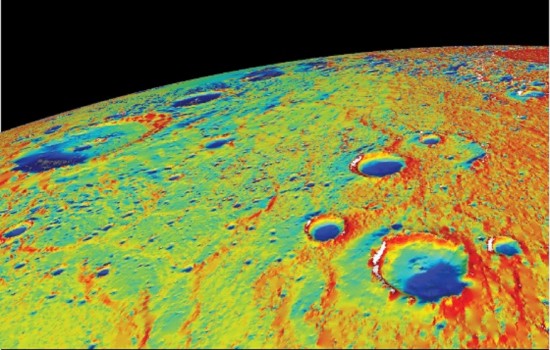
A temperature map of Mercury’s north pole calculated from MESSENGER data. Credit: NASA/UCLA/JHUAPL/Carnegie Institution of Washington
Dec 03, 2012
Is there frozen water on Mercury?
Some say the world will end in fire,
Some say in ice.
From what I’ve tasted of desire
I hold with those who favor fire.
But if it had to perish twice,
I think I know enough of hate
To say that for destruction ice
Is also great
And would suffice.
— Robert Frost
Recent information from the MESSENGER spacecraft, currently in orbit around the planet Mercury, indicates that there is “abundant water ice and other frozen volatile materials” within the deep, permanently shaded craters found near Mercury’s north pole.
The analysis is not conclusive, however, since the instruments onboard MESSENGER are measuring concentrations of hydrogen and interpreting those measurements to be the signature of water ice.
Earth’s Moon is 3472 kilometers in diameter and Mercury is 4878 kilometers in diameter and their surfaces are almost identical in appearance. The lack of atmosphere and low gravity contribute to a lack of erosion on both bodies, but the various formations on both reveal a high level of congruency. The surfaces of the Moon and Mercury are also composed primarily of basalt, the most common mineral in the Solar System.
Mercury is believed to be almost 75% iron surrounded by a thin shell of silicon-rich rock. Conventional theories of planet formation have no explanation for such a configuration. If it formed in the same protoplanetary nebula as the rest of the Solar System, then the abundance of iron remains a mystery because the ratio of iron to silicon is opposite to the other rocky planets.
Mercury is thought to have a molten core generating a magnetic field, but no one knows if it is working like Earth’s is supposed to work or if the field is part of the crust, like Mars. No one understands how a molten core exists on Mercury, since the planet appears cold and dead. The molten interior should have cooled off eons ago.
Water is built from two hydrogen atoms and an oxygen atom. Hydrogen arrives on Mercury in the same way it arrives on the Moon: from the solar wind. It travels along as a proton with its one electron stripped. If a hydrogen atom is removed from water, it becomes a hydroxyl molecule. Water and hydroxyl can bind to surface regolith through electrical forces. Solar wind protons can form hydrogen atoms when they pick up loose electrons from Mercury’s charged surface, as well. The hydrogen might then combine with ionized oxygen atoms to form water.
If water and other volatiles are on Mercury then it is because it and Earth were part of the same grouping of planets that wandered into the realm of the Sun long ago. We most likely shared a similar birth, with similar chemical gifts.
From an Electric Universe perspective, the sparse presence of water on Mercury is not surprising, although the catastrophic nature of Mercury’s experiences over time have removed most of what was once there, leaving only a pale shadow behind.
The moons of Jupiter and the other gas giant planets suggest that Mercury could have been similar to them long ago—largely covered in ice. Perhaps what has been seen in the deep polar craters on Mercury are all that remains of what might have once been a frozen moon. This depends of Mercury occupying an entirely different place in the Sun’s family and then moving to its present position.
Electric Universe advocate Wal Thornhill suggests another possibility: “Water ice is a highly unlikely answer to the puzzle. Once again, there is an electrical possibility. Mercury is likely to have a weak dipolar magnetic field. Mercury, like all planets is connected to the solar circuit. That connection follows the magnetic field down to the poles. Any remanent magnetism of the electrical craters at the pole will tend to focus the plasma discharges upon those craters. In the near vacuum at Mercury’s surface, electrons will strike the surface and form more dense plasma. If sufficiently dense, the plasma layer acts like a metallic surface coating and returns a strong radar echo.”
Stephen Smith












